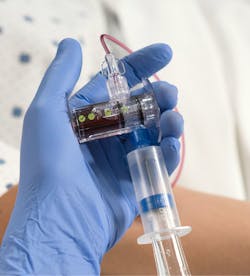In recent history, intravenous (IV)systems, medications and other necessary devices and items for patient care have undergone shortages. Phenomena, like these, consequently, were the ripple effects of devastating public health and environmental crises.
As Healthcare Purchasing News reported in an article last year, “A series of unfortunate IV events, Crisis = Recalls + Seasonal Virus + Supplier Exit + Natural Disaster,” “Within the last decade, healthcare providers and suppliers have experienced at least two notable shortages of IV and pharma solutions.”
“The first emerged in the 2013-2014 timeframe, following a Food and Drug Administration recall, coupled with an aggressive flu strain season and the exit of the No. 2 supplier,” HPN reported. “The second emerged in the 2016-2017 timeframe, following a hurricane that damaged the Puerto Rican manufacturing plant of the No. 1 supplier, but also cut out power by damaging the electrical grid on the island nation it hit, which further hampered production.”1
Pandemic-drawn direction for resources
COVID-19, of course, is the newest and most catastrophic public health emergency disrupting the healthcare landscape and lives around the world today. This time, however, the high demand for inventory in hospital and critical care spanned from medical, testing, and personal protective resources.
“As organizations that represent or collaborate with individuals and institutions at the forefront of delivering health care in the midst of the COVID-19 pandemic, we are vitally concerned with the shortages of masks, face shields and other personal protective equipment (PPE), ventilators, swab kits, and testing capacity that are critically needed by frontline caregivers and patients,” emphasized several healthcare associations in a March statement released by the American Hospital Association.2
The associations expressed, “We strongly support emergency efforts at the federal level to dramatically increase the production and distribution of PPE and other necessary medical equipment and supplies. We also support the availability of telehealth services during this time to use less PPE while preventing the spread of infection.”
As far as IV systems go, national policies and recommendations were issued to ensure availability for any care needed. This guidance included:
•FDA – In April, as the number of cases magnified, the U.S. Food and Drug Administration (FDA) released new guidance on the manufacture and availability of infusion pump systems.
“FDA is issuing this guidance to provide a policy to help expand the availability and remote capabilities of infusion pumps and their accessories for health care professionals during the COVID-19 pandemic,”3 stated the FDA in a guidance document.
While an enforcement policy from the FDA outlined the specific scope of devices needed for care.
“FDA believes it is important to help facilitate availability of the devices, which includes large volume parenteral (LVP) infusion pumps, syringe infusion pumps, PCA infusion pumps, and ambulatory infusion pump devices, and their accessories, in order to support patients who require sustained infusion therapy in the context of the COVID-19 public health emergency,”4 the FDA addressed.
The agency noted, “Patients infected with COVID-19 may require continuous infusion of medications, nutrition, and/or other fluids. As such, FDA recognizes the need to help increase access to an adequate supply of devices to treat patients who need these therapies and to help foster technologies that maintain a safer physical distance between the health care provider and patient affected by COVID-19.”anee
The policy went on to describe measures manufacturers may take to adequately produce and supply needed equipment.
“Wherever possible, health care facilities should use FDA-cleared infusion pumps and accessories to provide infusion therapy, or a device authorized by an Emergency Use Authorization (EUA),” they explained.
Additionally, they indicated, “More specifically, this policy will create more flexibility for manufacturers that make device modifications to address manufacturing limitations or supply shortages related to the public health emergency.”
• ASA – In June, as the crisis surged on, the American Society of Anesthesiologists (ASA) made recommendations on the availability and preservation of IV drugs.
“Because of the COVID-19 pandemic, many institutions throughout the country are anticipating or currently experiencing shortages of vital anesthetic drugs that are also commonly used in intensive care units (ICUs),”5 set forth the ASA in a press release.
The society specified, “When institutions approach capacity status in their ICUs and have concerns regarding the availability of sedating and paralytic drugs, anesthesiologists should strive to conserve vital drugs for use in ICUs. Shortages of particular concern include propofol, dexmedetomidine, midazolam, and neuromuscular blocking agents.”
Further, they directed on specific protocols for use of IV anesthetics and agents in surgical care.
“Surgeries that are performed in the operating room should avoid use of total intravenous anesthetics (TIVA) whenever possible to preserve the supply of intravenous agents,” the society stated.
They continued, “Efforts should be made to employ the use of regional anesthetic techniques wherever suitable. In the event that intravenous sedation agents are unavailable, inhalational anesthetics have the potential to be used for sedation when anesthesia machines are being used for prolonged periods as ICU ventilators. Use of these agents mandates the continuous presence of a trained anesthesia professional on a 24/7 basis in order to facilitate their use.”
• FDA again – By September, the FDA reversed an Emergency Use Authorization (EUA) they issued in May for infusion pump systems.
The FDA wrote in a letter to manufacturers, “This letter is to notify you of the revocation of the Emergency Use Authorization (EUA) issued May 13, 2020, for emergency use of infusion pumps and infusion pump accessories for use by healthcare providers (HCPs) to treat conditions caused by the Coronavirus Disease 2019 (COVID-19) with the controlled infusion of medications, total parenteral nutrition (TPN), and/or other fluids.”6
The agency went on, “FDA has determined that circumstances make revocation of this EUA appropriate to protect the public health or safety. Based on information and experience since issuance of the umbrella EUA, FDA has determined that circumstances support revocation of the umbrella EUA. Instead, FDA may issue individual EUAs for infusion pumps and infusion pump accessories that meet the requisite EUA statutory criteria.”
Focus on system performance, safety and education
Today, manufacturers of IV systems and related technology forge ahead with design, function and safety. Several organizations, as well, provide educational resources and training for staff.
With regard to monitoring infusion during MRI imaging, B. Braun Medical Inc. announced in a press release that they have “received 510(k) clearance from the US Food and Drug Administration for the SpaceStation MRI to allow Space infusion pumps to continuously deliver medications to patients within the MRI suite.”7
Additionally, they explained, “The SpaceStation MRI is designed to shield Space infusion pumps against 1.5-T and 3.0-T magnetic fields to protect the MR scanner and provide interference-free images. Long infusion lines are no longer needed and hospital-wide Space infusion pumps are now able to safely transition patients into the imaging suite with the SpaceStation MRI.”
Concentrated on monitoring blood culture, Magnolia Medical Technologies, Inc. reported in a press release that they were “selected as the Innovative Technology Supplier of the Year by Vizient Inc. The award was presented in a virtual Awards Ceremony as part of the 2020 Vizient Connections Education Summit.”8
Criteria for the award included, “the supplier whose technology has advanced patient care, advanced patient safety and health care worker safety, and/or delivered solutions that drive incremental improvement to an organization’s care or business model,” they noted.
Focusing on IV education and skill building for staff, the Association for Vascular Access (AVA) announced in a press release that they and B. Braun Medical Inc. have entered, “a long-term collaboration to improve training on the placement of peripheral intravenous catheters (PIVCs). Together the organizations will develop and provide a new series of online courses free of charge to medical, nursing, respiratory therapist, and other allied healthcare schools – the first of which is being piloted at several leading nursing schools.”9
Additionally, they noted that they will work together to “create a certificate program for students who complete the courses that will attest to their foundational knowledge in PIVC placements with future employers. The eLearning module will feature interactive graphics and hi-definition videos in addition to the necessary text critical to enhancing the PIVC education in healthcare. It will focus on key aspects like proper device placement, assessment, and insertion to instill confidence in students of all skill levels.”
Committed to safety in care in today’s crisis and beyond, the Institute for Safe Medication Practices (ISMP) reported in a press release that they and ECRI have launched “a joint Patient Safety Organization (PSO), an important step in making medication, medical devices, and healthcare practices safer for patients across all care settings, now during the COVID-19 pandemic, and into the future. The nonprofit organizations had each been federally designated PSOs since the program began in 2008.”10
Specifically, they indicated, “In an effort to reduce nursing exposure, conserve PPE in short supply, and quickly respond to pump alarms, hospitals overrun with COVID-19 patients moved bedside IV infusion pumps and administration sets into hallways outside patient rooms. The risks and challenges from this innovative process included potential shortage of extension tubing sets, more frequent alarms at high flow rates, and other technology challenges. ISMP medication safety experts and ECRI’s clinical engineering team worked together to provide real-time guidance to ensure safety for this technology work-around.”
References:
1. A series of unfortunate IV events, Crisis = Recalls + Seasonal Virus + Supplier Exit + Natural Disaster Rick Dana Barlow, Healthcare Purchasing News, November 2019, https://www.hpnonline.com/sourcing-logistics/article/21077022/a-series-of-unfortunate-iv-events
2. Public statement on the shortages of critical medical equipment, March 27, 2020, https://www.aha.org/press-releases/2020-03-27-public-statement-shortages-critical-medical-equipment
3. GUIDANCE DOCUMENT, Enforcement Policy for Infusion Pumps and Accessories During the Coronavirus Disease 2019 (COVID-19) Public Health Emergency, Guidance for Industry and FDA Staff, APRIL 2020, https://www.fda.gov/regulatory-information/search-fda-guidance-documents/enforcement-policy-infusion-pumps-and-accessories-during-coronavirus-disease-2019-covid-19-public
4. Enforcement Policy for Infusion Pumps and Accessories During the Coronavirus Disease 2019 (COVID-19) Public Health Emergency Guidance for Industry and Food and Drug Administration Staff April 2020 U.S. Department of Health and Human Services Food and Drug Administration Center for Devices and Radiological Health (CDRH) Office of Product Evaluation and Quality (OPEQ), https://www.fda.gov/media/136701/download
5. Critical Care Drug Recommendations for COVID-19 During Times of Drug Shortages, June 25, 2020, https://www.asahq.org/about-asa/newsroom/news-releases/2020/06/critical-care-drug-recommendations-for-covid-19-during-times-of-drug-shortages
6. Infusion Pumps and Infusion Pump Accessories, https://www.fda.gov/media/142374/download
7. B. Braun Receives FDA Clearance for SpaceStation MRI: Allows Space® Infusion Pumps to Continuously Deliver Medications Within the MRI Suite, Thursday, August 27, 2020, https://www.bbraunusa.com/en/company/newsroom/news/2020/quarter-4/association-for-vascular-access-and-b--braun-partner-to-raise-st.html
8. Magnolia Medical Awarded Innovative Technology Supplier of the Year by Vizient Inc., https://magnolia-medical.com/press-releases/vizient-innovative-technology-supplier-of-the-year/
9. Ava and B. Braun Partner to Raise Standards and Enhance Training for IV placement, Monday, October 5, 2020, https://www.avainfo.org/news/528110/AVA-and-B.-Braun-Partner-to-Raise-Standards-and-Enhance-Training-for-IV-Placement.htm#comments
10. ECRI and the Institute for Safe Medication Practices Launch New Patient Safety Organization, August 17, 2020, https://www.ismp.org/news/ecri-and-institute-safe-medication-practices-launch-new-patient-safety-organization
About the Author

Ebony Smith
Ebony Smith was previously Managing Editor for Healthcare Purchasing News.


